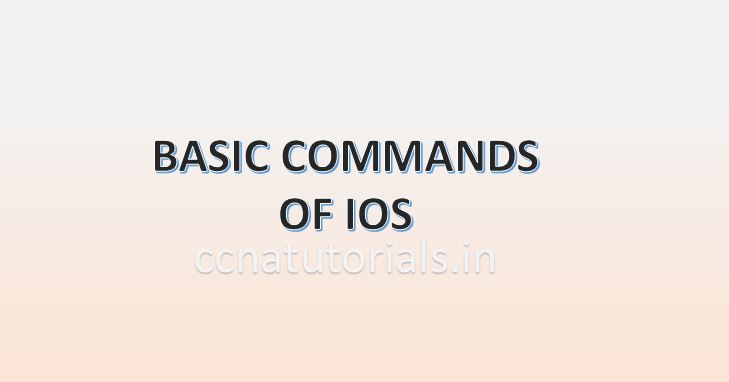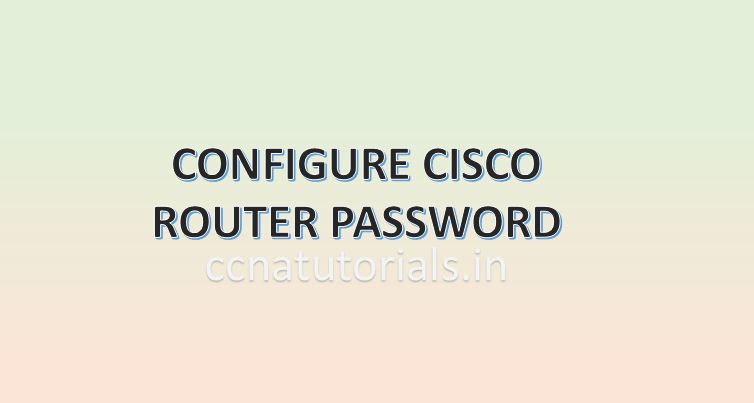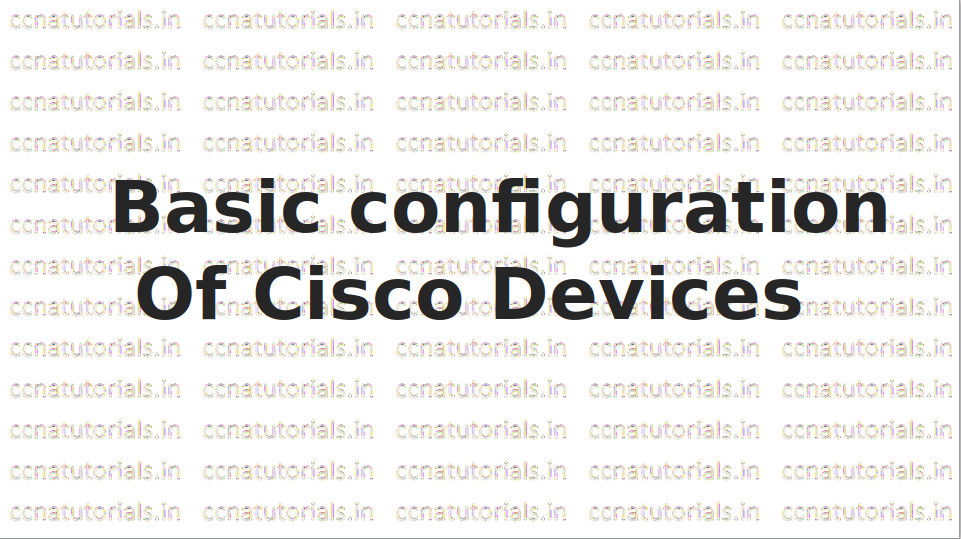In this article I describe the running and startup configuration in routers and switches for CCNA Exam. running and startup configuration is a part of IOS. IOS is acronym for Internetwork Operating System which is related to Cisco networking devices. IOS Internetwork Operating System provides the facility to configure and maintain the networking devices in the network by using some Cisco IOS commands. The configuration remain save in IOS memory via two way running and startup configuration.
Basically running configuration is the settings which are running when a router is in functional condition. It is not necessary the running configuration remain save and come back when the router rebooted due to any reason. The startup configuration keep the setting in hard memory of router. Every time when router power on the startup configuration settings comes by default. The running configuration deleted automatically when the router goes power off. It is just like working with RAM and ROM.
The network administrator can change the running and startup configuration and maintain the networking device in a network by using Cisco IOS commands. IOS is an application which run as operating system for the networking devices like router or switch. Command Line Interface CLI in Cisco IOS provides a command line interface to a remote computer with various Cisco IOS command modes for network administrator. IOS load after a fix booting sequence every time when we boot the router or switch. On booting the router the startup configurtion load in to the RAM of router So before learning about the Cisco IOS command modes lets see some basic fundamentals of IOS Internetwork Operating System. You can also read the IOS booting sequence here.
IOS Internetwork Operating System
IOS Internetwork Operating System is a Cisco propriety for Cisco networking devices like routers and switches. Network administrator can work with various Cisco IOS command modes of any networking device from a computer in the network. CLI is generally know as the Command Line Interface CLI in Cisco IOS. All the routing configuration and other settings saved in the IOS Internetwork Operating System of router. IOS Internetwork Operating System provide to do any changes on any interface or the router or switch. IOS Internetwork Operating System provide to maintain the networking device from a very far location remotely. IOS of Cisco can be integrated with other networking devices like IBM and SNA. The Cisco IOS command modes are very user friendly, the user can take the help about any command from CLI for a device.
The IOS Internetwork Operating System allow to configure the encryption, routing and authentication in the router or switches. IOS Internetwork Operating System have three variants XE, XR and Nexus. The XE version available with aggregation service routers and catalyst switches. XR version available with carrier routers. Nexus allow to configure the Nexus family devices. Before IOS Internetwork Operating System Cisco run the CatOS on its networking devices. IOS Internetwork Operating System is operating system independent means you can run the IOS on windows as well as on Linux or Unix operating system. The IOS developed in the decade of 1980 for Cisco routers.
Types of memory used by Cisco routers for IOS Internetwork Operating System
There are multiple types of memory available in the router which takes part in the IOS Internetwork Operating System. It is necessary to know about the various types of memory used in router for various purpose. We can say that each memory is responsible for different task for the IOS Internetwork Operating System. A Cisco router contains four main memories RAM, ROM, NVRAM and Flash memory.
RAM stands for Random Access Memory which is like a RAM in any computer. In a Router, RAM stores the running configuration and routing table with routing protocol. The IOS loaded in the RAM After the completion of IOS Booting sequence in the router. RAM stores the data until the router is power ON. After shutting down the router, all data stored in RAM will erase automatically.
ROM the Read Only Memory stores the data permanently in it. The ROM loaded the previously saved configuration in IOS Internetwork Operating System of router. Mostly the bootstrap start up program stored in ROM. The initial function known as POST is also stored in ROM and run during the first step of IOS Booting sequence in router.
NVRAM memory is a type of RAM but it is Non-Volatile. The data saved previously in the NVRAM loaded after completion of IOS Booting sequence in router. It means the data stored in it doesn’t depends on Power on or off. We can write the data multiple times on it. ROM is read only memory. The main difference between NVRAM and ROM is that data of NVRAM can be changed by configuration.
Another type of memory available in router is Flash memory. Flash memory keep save the IOS image. Flash memory is read and writable memory. In case of any error in the IOS Booting sequence the image of IOS can be used for booting the router.
Running and Startup configuration in brief
Cisco router function on Running and Startup configuration. Both configurations have different state. Router boot with startup configuration remember the booting sequence of router. The startup configuration may be stored in NVRAM or TFTP server. The boot loader or router find it and load into RAM of router. Every time when you do any changes in running configuration, it is necessary to save the running configuration into startup configuration. Let’s discuss in brief about both running and startup configuration.
The hostname of router in the article running and startup configuration is ccnatutorials.
Startup configuration of cisco router
The Startup configuration stores in NVRAM or TFTP server. By default the startup configuration keep the basic settings. Startup configuration store sufficient settings to keep the router on initially. Later on a user can change the startup configuration according to requirement of network. Requirement depends on network administrator need like IP address of each interface. Routing protocols configuration saved in startup configuration.
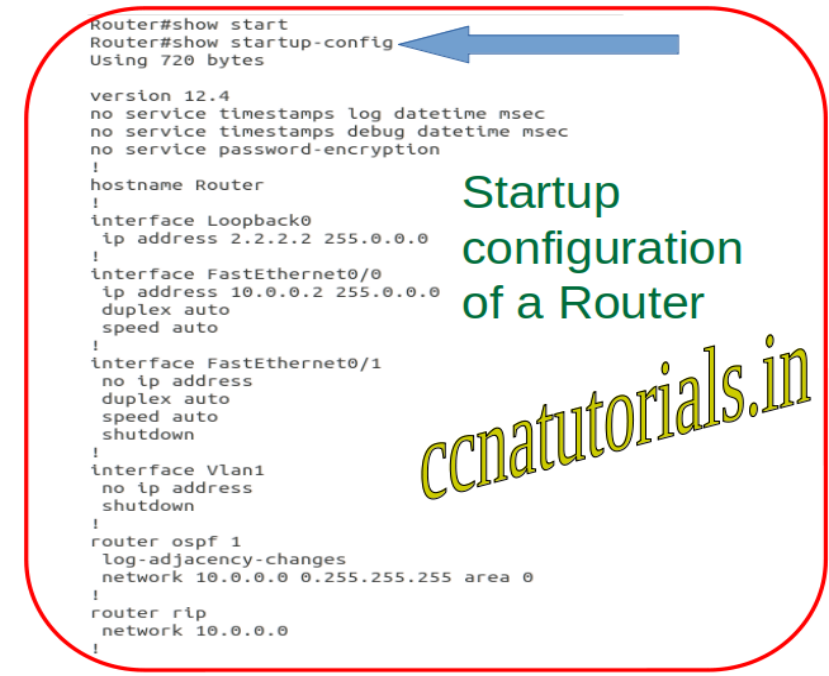
Startup configuration remains save when the router is power off. Startup configuration load into RAM and known as running configuration. We save the routing protocols and other configuration in startup configuration file so next time when the router reboot the settings remains unchanged. You can say it is like hard drive of a computer. The information remain unchanged until the changes done manually by user.
Running configuration of cisco router
Running configuration stores in RAM of the router. Running configuration settings remain unchanged until the power is on. Once the router power off the running configuration erased. To avoid this we keep a copy of running configuration in startup configuration. Router boot on startup configuration. Running and Startup configuration Running configuration stores in RAM of the router. Running configuration settings remain unchanged until the power is on. Once the router power off the running configuration erased. To avoid this we keep a copy of running configuration in startup configuration. Router boot on startup configuration.
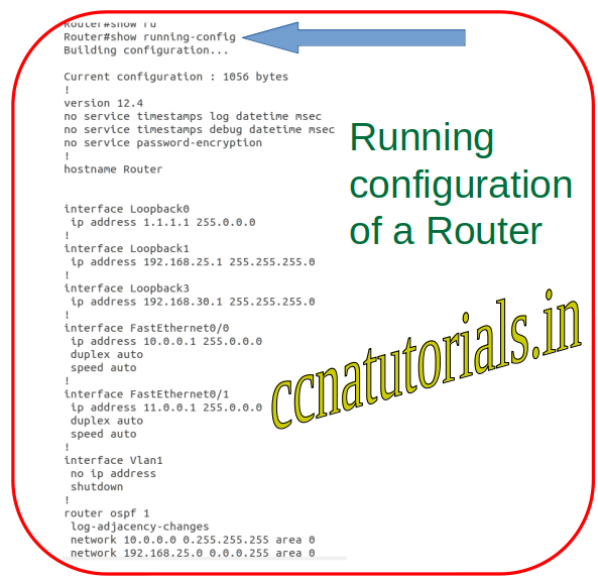
A user can change the settings of running configuration of a router. On changes in running configuration router immediately starts works on the current configuration. We need to save the running configuration. The startup configurations load into RAM and work like running configurations. We changes in running configurations and save it in startup configurations. Cisco router function on Running and Startup configurations.
Both configurations have different state. Router boot with startup configuration remember the booting sequence. A user can change the settings of running configuration of a router. On changes in running configuration router immediately starts works on the current configuration. We need to save the running configuration. The startup configurations load into RAM and work like running configurations. We changes in running configurations and save it in startup configurations.
Copy running configuration into startup configuration
It is necessary every time when you do any changes in the running configuration. Running configurations can be copied to startup configurations file from privilege mode. Firstly we have to go to the privilege mode then run the copy command.
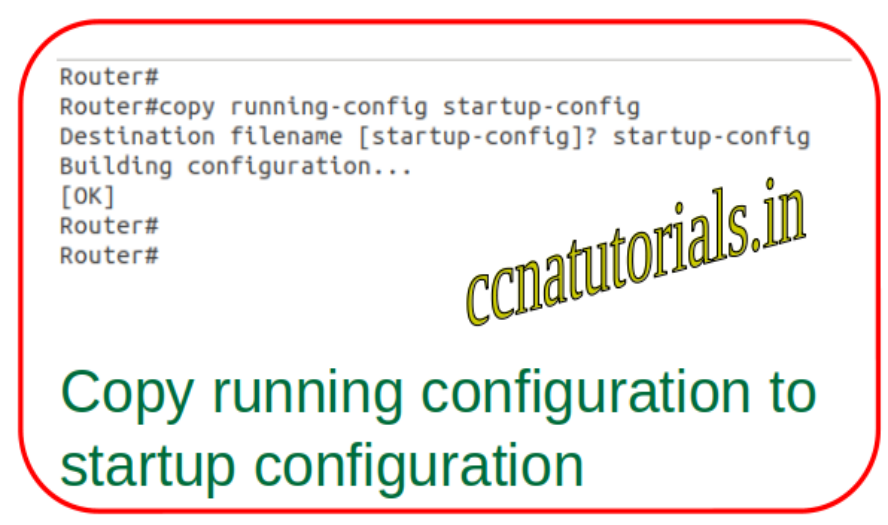
By copy the running configurations into startup configurations we can save the current configurations in NVRAM. We can also save the running configuration into TFTP server in the same network.
In this article I described the running and startup configuration of Cisco IOS. I hope you found this article helpful. For any query or suggestion on this article you may contact us or drop a comment below. Your suggestions are always welcome by us.



